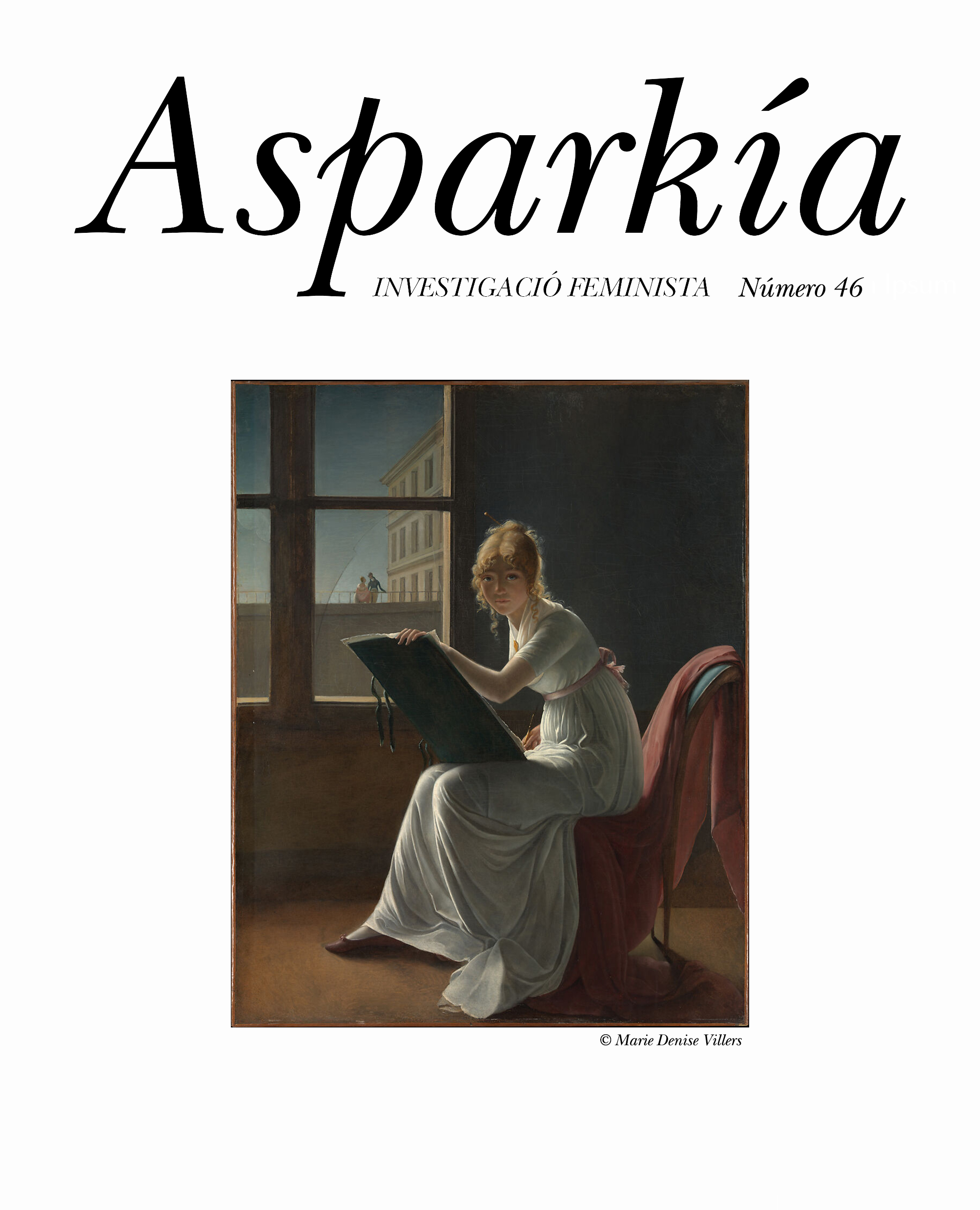The Feminist Net.Art as an Identity, Political and Emancipatory Instrument for the Female Subject
Main Article Content
Abstract
The net.art artistic movement, situated in the early internet era, from the late 20th century to the early 21st century, challenges the presumed neutrality of cyberspace, which was, at that time, considered free from patriarchal biases. This article revisits and analyzes ten net.art works that are fundamental to feminism within a contemporary digital culture context. The works by Wilding (1974), VNS Matrix (1992), Lialina (1996), Sollfrank (1997), Cheang (1998), Bookchin (1999), Abrahams (2001-2003), Flanagan (2003), Menkam (2010), and Laboria Cuboniks (2015) reclaim the creative agency of women artists within the technological domain and establish an identity framework for the female subject through digital art as a political and activist branch of cyberfeminism.
Downloads
Article Details
References
Agudo Martínez, María Josefa. (2021). Net.art y feminización en Elías Zambrano, Rodrigo y Jiménez-Marín, Gloria (Eds.), Reflexiones en torno a la comunicación organizacional, la publicidad y el audiovisual, desde una perspectiva multidisciplinar (pp. 333-351). Fragua. https://idus.us.es/bitstream/handle/11441/106019/Net.art%20y%20feminización.%20.pdf?sequence=1&isAllowed=y
Baigorri, Laura y Cilleruelo, Lourdes. (2005). Net.art: una aproximación crítica a la primera década de arte online. BRUMARIA. https://scholar.google.es/citations?view_op=view_citation&hl=es&user=cXKkINUAAAAJ&citation_for_view=cXKkINUAAAAJ:NMxIlDl6LWMC
Catlow, Ruth. (4 de febrero de 2010). If not you not me. Furtherfield. https://www.furtherfield.org/if-not-you-not-me-2/
Connor, Michael. (10 de noviembre de 2016). Speaking in Net Language: My Boyfriend Came Back from the War. Rhizome. https://rhizome.org/editorial/2016/nov/10/my-boyfriend-came-back-from-the-war/
Connor, Michael. (9 de marzo de 2017). Flooding the Museum. An Interview with Cornelia Sollfrank. Rhizome. https://rhizome.org/editorial/2017/mar/09/flooding-the-museum/
Doménech, Oreto. (2015). Cuerpo, lectura y mujer en Separation/Séparation de Annie Abrahams, Underbelly de Christine Wilks y Vniverse de StephanieStrickland. Texto Digital, 11(2), 128-147. https://doi.org/10.5007/1807-9288.2015v11n2p128
Evans, Claire L. (11 de diciembre de 2014). An Oral History of the First Cyberfeminists. Vice. https://www.vice.com/en/article/z4mqa8/an-oral-history-of-the-first-cyberfeminists-vns-matrix
Fernández, María y Wilding, Faith. (2019). Situar los ciberfeminsimos en Zafra, Remedios y López-Pellisa, Teresa (Eds), Ciberfeminismo de VNSMatrix a Laboria Cuboniks (pp. 305-316). Holobionte ediciones.
Gago Gelado, Rocío. (2019). Ciberfeminismo en España: discurso teórico y prácticas digitales. Institut Universitari d’Estudis de Gènere. Universitat d’Alacant.
García Manso, Almudena. (2007). Cyborgs, mujeres y debates. El ciberfeminismo como teoría crítica. Barataria. Revista Castellano-Manchega De Ciencias Sociales, (8), 13-26. https://revistabarataria.es/web/index.php/rb/article/view/202
García-Oliveros, Elena. (2016). Cuando el autor es el patriarcado. Desmaterialización del arte: del arte público al ciberfeminismo. Anuario del Departamento de Historia y Teoría del Arte, 28, 73-93. https://doi.org/10.15366/anuario2016.28.004
Gleeson, Jules Joanne. (19 de octubre de 2019). Breakthroughs & Bait: On Xenofeminism & Alienation. Meta Mute. https://www.metamute.org/editorial/articles/breakthroughs-bait-xenofeminism-alienation
Greene, Rachel. (2000). Una Historia del Arte en internet. IdUS. Depósito de Investigación de la Universidad de Sevilla. https://core.ac.uk/reader/51389800
Haraway, Donna. (1991). Manifiesto cíborg. Kaótica Libros. Trad. Kaótica Libros.
Kuni, Verena. (2019). El futuro es Femail. Algunas reflexiones sobre la estética y la política del ciberfeminismo en Zafra, Remedios y López-Pellisa, Teresa (Eds.), Ciberfeminismo. De VNS Matrix a Laboria Cuboniks (pp. 171-186). Holobionte Ediciones. Trad. Cristina Jurado et al.
Laboria Cuboniks. (2015). Xenofeminismo. Una política por la alienación. Verso Books.
Navarrete Tudela, Ana. (2011). Diferentes, desiguales y desconectadas. ¿Quién es quién en las industrias tecnológicas? Asparkía. Investigació Feminista, (22), 17-31. https://www.e-revistes.uji.es/index.php/asparkia/article/view/595
Perla Sasson, Henry. (2007). North Meets South: Jorge Luis Borges’s “The Interloper” and Natalie Bookchin’s Media Experiment The Intruder en Lang, Peter, Borges 2:00: From text to virtual words (pp. 101-112). Latin America. Interdisciplinary Studies. https://bookchin.net/wp-content/uploads/2015/09/borges2.0.pdf
Pezet, William. (2021). Separation Poem. Documentation of Separation after discontinuation of the Flash plugin April 2021. bram.org. https://www.bram.org/separation/archives/separationdocENG.pdf
Reverter Bañón, Sonia. (2001). Reflexiones en torno al Ciberfeminismo. Asparkía. Asparkía. Investigació Feminista, (12), 35-51. https://www.e-revistes.uji.es/index.php/asparkia/article/view/883
Robinson, Hilary. (1998). Más allá de los límites: feminidad, cuerpo y representación en Deepwell, Katy (Ed.), Nueva crítica feminista de arte. Estrategias críticas (pp. 241-255). Cátedra.
Sollfrank, Cornelia. (2019). La verdad sobre el ciberfeminismo en Zafra, Remedios y López-Pellisa, Teresa (Eds.), Ciberfeminismo. De VNS Matrix a Laboria Cuboniks (pp. 251-257). Holobionte Ediciones. Trad. Toni Navarro et al.
Telemann, Tila. (s.f.). Hackers are artists — and some artists are hackers. Tila Telemann speaks with Cornelia Sollfrank. Artwarez. https://artwarez.org/projects/femext/content/interviewEN.html
Vico Trujillo, Alejandro. (2015). Nuevos conceptos fotográficos en la era digital. Asociación Aragonesa de Críticos de Arte, (30). http://www.aacadigital.com/contenido.php?idarticulo=1063
Wacjman, Judy. (2006). El tecnofeminismo. Feminismos.
Washko, Angela. (s.f.). Remixing as a feminist protest. Mary Flanagan. [domestic], 2003. Angela Washko. https://angelawashko.com/artwork/4216737-Mary%20Flanagan%3a%20%22%5bdomestic%5d%22.html
Wilding, Faith. (2004). ¿Dónde está el feminismo en el ciberfeminismo? Lectora, (10), 141-151. https://ddd.uab.cat/pub/lectora/20139470n10/20139470n10p141.pdf
Wilding, Faith y Critical Art Ensemble. (2019). Apuntes sobre la condición política del ciberfeminismo en Zafra, Remedios y López-Pellisa, Teresa (Eds), Ciberfeminismo. De VNS Matrix a Laboria Cuboniks (pp. 213-228). Holobionte Ediciones. Trad. Cristina Jurado et al.
Zafra, Remedios. (s.f.-a). Separation. Annie Abrahams. Habitar en (punto) net. http://www.2-red.net/habitar/castell/sep.html
Zafra, Remedios. (s.f.-b). Violencia sin cuerpos. The intruder 1999. remedioszafra.net. https://www.remedioszafra.net/carceldeamor/vsc/netart_/intruder.html
Zafra, Remedios. (2005). Cuerpos ¿qué importan?, cibersexo y videojuegos. Mutation.Fem https://www.remedioszafra.net/carceldeamor/vsc/textos/textocqi.html
Zafra, Remedios. (2016). Transcripción del evento en directo, online y presencial de la navegación de “Brandon” de Shu Lea Cheang. toxiclesbian.org. http://toxiclesbian.org/wp-content/uploads/2017/proyectos-investigacion/Transcrip_evento_esp.pdf
Zafra, Remedios. (2018). Redes y (Ciber)feminismos. La revolución de la representación que derivó en alianza. Revista DIGITOS, (4), 11-22. https://doi.org/10.7203/rd.v0i4.116
Zafra, Remedios. (2019). Prólogo en Zafra, Remedios y López-Pellisa, Teresa (Eds.), Ciberfeminismo. De VNS Matrix a Laboria Cuboniks (pp. 11-39). Holobionte ediciones. Trad. Cristina Jurado et al.


